Fang Liu
Multimodal Learning for Fake News Detection in Short Videos Using Linguistically Verified Data and Heterogeneous Modality Fusion
Sep 19, 2025Abstract:The rapid proliferation of short video platforms has necessitated advanced methods for detecting fake news. This need arises from the widespread influence and ease of sharing misinformation, which can lead to significant societal harm. Current methods often struggle with the dynamic and multimodal nature of short video content. This paper presents HFN, Heterogeneous Fusion Net, a novel multimodal framework that integrates video, audio, and text data to evaluate the authenticity of short video content. HFN introduces a Decision Network that dynamically adjusts modality weights during inference and a Weighted Multi-Modal Feature Fusion module to ensure robust performance even with incomplete data. Additionally, we contribute a comprehensive dataset VESV (VEracity on Short Videos) specifically designed for short video fake news detection. Experiments conducted on the FakeTT and newly collected VESV datasets demonstrate improvements of 2.71% and 4.14% in Marco F1 over state-of-the-art methods. This work establishes a robust solution capable of effectively identifying fake news in the complex landscape of short video platforms, paving the way for more reliable and comprehensive approaches in combating misinformation.
An Empirical Study on Failures in Automated Issue Solving
Sep 17, 2025Abstract:Automated issue solving seeks to autonomously identify and repair defective code snippets across an entire codebase. SWE-Bench has emerged as the most widely adopted benchmark for evaluating progress in this area. While LLM-based agentic tools show great promise, they still fail on a substantial portion of tasks. Moreover, current evaluations primarily report aggregate issue-solving rates, which obscure the underlying causes of success and failure, making it challenging to diagnose model weaknesses or guide targeted improvements. To bridge this gap, we first analyze the performance and efficiency of three SOTA tools, spanning both pipeline-based and agentic architectures, in automated issue solving tasks of SWE-Bench-Verified under varying task characteristics. Furthermore, to move from high-level performance metrics to underlying cause analysis, we conducted a systematic manual analysis of 150 failed instances. From this analysis, we developed a comprehensive taxonomy of failure modes comprising 3 primary phases, 9 main categories, and 25 fine-grained subcategories. Then we systematically analyze the distribution of the identified failure modes, the results reveal distinct failure fingerprints between the two architectural paradigms, with the majority of agentic failures stemming from flawed reasoning and cognitive deadlocks. Motivated by these insights, we propose a collaborative Expert-Executor framework. It introduces a supervisory Expert agent tasked with providing strategic oversight and course-correction for a primary Executor agent. This architecture is designed to correct flawed reasoning and break the cognitive deadlocks that frequently lead to failure. Experiments show that our framework solves 22.2% of previously intractable issues for a leading single agent. These findings pave the way for building more robust agents through diagnostic evaluation and collaborative design.
Lightweight Implicit Neural Network for Binaural Audio Synthesis
Sep 17, 2025Abstract:High-fidelity binaural audio synthesis is crucial for immersive listening, but existing methods require extensive computational resources, limiting their edge-device application. To address this, we propose the Lightweight Implicit Neural Network (LINN), a novel two-stage framework. LINN first generates initial estimates using a time-domain warping, which is then refined by an Implicit Binaural Corrector (IBC) module. IBC is an implicit neural network that predicts amplitude and phase corrections directly, resulting in a highly compact model architecture. Experimental results show that LINN achieves statistically comparable perceptual quality to the best-performing baseline model while significantly improving computational efficiency. Compared to the most efficient existing method, LINN achieves a 72.7% reduction in parameters and significantly fewer compute operations (MACs). This demonstrates that our approach effectively addresses the trade-off between synthesis quality and computational efficiency, providing a new solution for high-fidelity edge-device spatial audio applications.
OmniMRI: A Unified Vision--Language Foundation Model for Generalist MRI Interpretation
Aug 24, 2025Abstract:Magnetic Resonance Imaging (MRI) is indispensable in clinical practice but remains constrained by fragmented, multi-stage workflows encompassing acquisition, reconstruction, segmentation, detection, diagnosis, and reporting. While deep learning has achieved progress in individual tasks, existing approaches are often anatomy- or application-specific and lack generalizability across diverse clinical settings. Moreover, current pipelines rarely integrate imaging data with complementary language information that radiologists rely on in routine practice. Here, we introduce OmniMRI, a unified vision-language foundation model designed to generalize across the entire MRI workflow. OmniMRI is trained on a large-scale, heterogeneous corpus curated from 60 public datasets, over 220,000 MRI volumes and 19 million MRI slices, incorporating image-only data, paired vision-text data, and instruction-response data. Its multi-stage training paradigm, comprising self-supervised vision pretraining, vision-language alignment, multimodal pretraining, and multi-task instruction tuning, progressively equips the model with transferable visual representations, cross-modal reasoning, and robust instruction-following capabilities. Qualitative results demonstrate OmniMRI's ability to perform diverse tasks within a single architecture, including MRI reconstruction, anatomical and pathological segmentation, abnormality detection, diagnostic suggestion, and radiology report generation. These findings highlight OmniMRI's potential to consolidate fragmented pipelines into a scalable, generalist framework, paving the way toward foundation models that unify imaging and clinical language for comprehensive, end-to-end MRI interpretation.
Gradient Boosting Decision Tree with LSTM for Investment Prediction
May 29, 2025Abstract:This paper proposes a hybrid framework combining LSTM (Long Short-Term Memory) networks with LightGBM and CatBoost for stock price prediction. The framework processes time-series financial data and evaluates performance using seven models: Artificial Neural Networks (ANNs), Convolutional Neural Networks (CNNs), Bidirectional LSTM (BiLSTM), vanilla LSTM, XGBoost, LightGBM, and standard Neural Networks (NNs). Key metrics, including MAE, R-squared, MSE, and RMSE, are used to establish benchmarks across different time scales. Building on these benchmarks, we develop an ensemble model that combines the strengths of sequential and tree-based approaches. Experimental results show that the proposed framework improves accuracy by 10 to 15 percent compared to individual models and reduces error during market changes. This study highlights the potential of ensemble methods for financial forecasting and provides a flexible design for integrating new machine learning techniques.
Logits DeConfusion with CLIP for Few-Shot Learning
Apr 16, 2025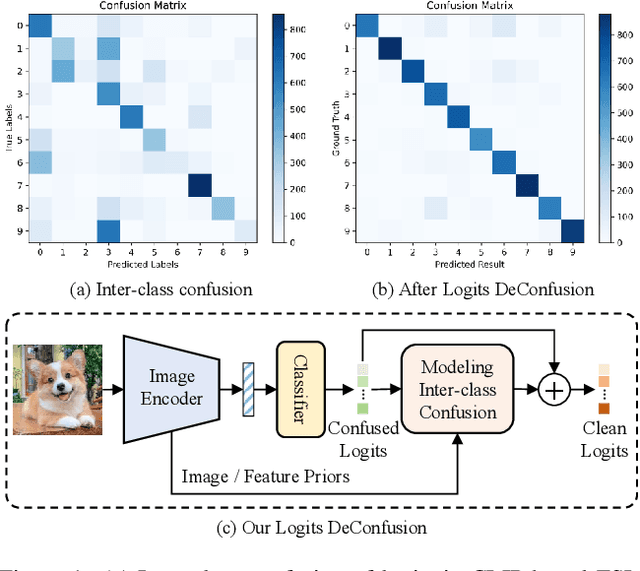
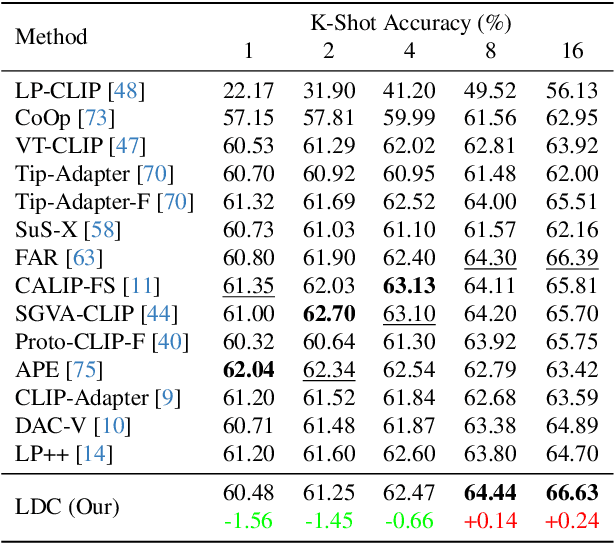
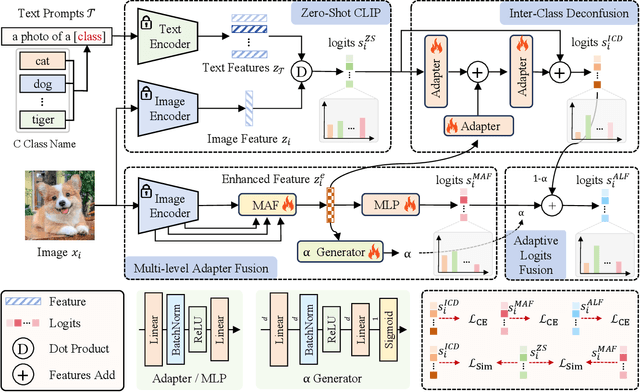
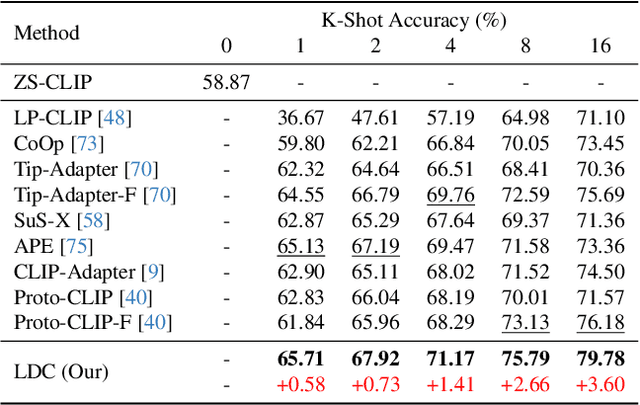
Abstract:With its powerful visual-language alignment capability, CLIP performs well in zero-shot and few-shot learning tasks. However, we found in experiments that CLIP's logits suffer from serious inter-class confusion problems in downstream tasks, and the ambiguity between categories seriously affects the accuracy. To address this challenge, we propose a novel method called Logits DeConfusion, which effectively learns and eliminates inter-class confusion in logits by combining our Multi-level Adapter Fusion (MAF) module with our Inter-Class Deconfusion (ICD) module. Our MAF extracts features from different levels and fuses them uniformly to enhance feature representation. Our ICD learnably eliminates inter-class confusion in logits with a residual structure. Experimental results show that our method can significantly improve the classification performance and alleviate the inter-class confusion problem. The code is available at https://github.com/LiShuo1001/LDC.
PVUW 2025 Challenge Report: Advances in Pixel-level Understanding of Complex Videos in the Wild
Apr 15, 2025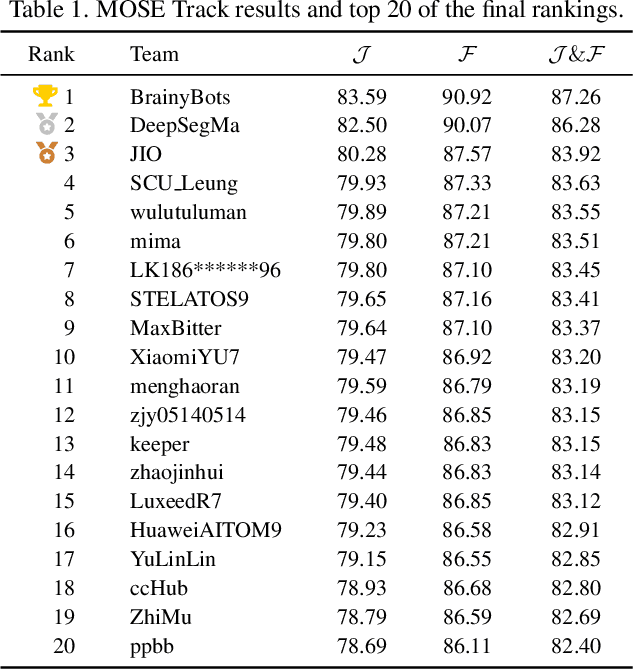
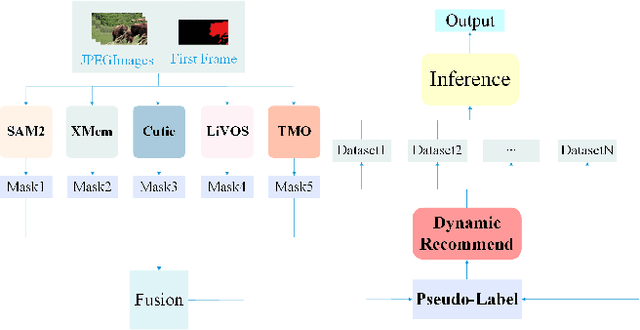
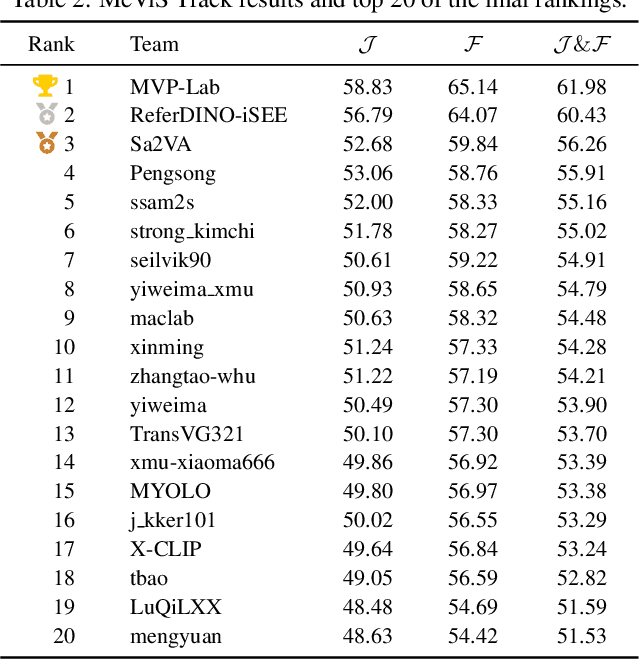
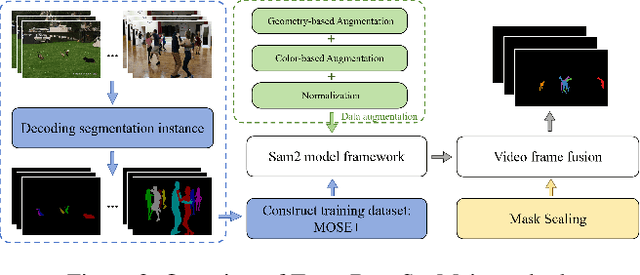
Abstract:This report provides a comprehensive overview of the 4th Pixel-level Video Understanding in the Wild (PVUW) Challenge, held in conjunction with CVPR 2025. It summarizes the challenge outcomes, participating methodologies, and future research directions. The challenge features two tracks: MOSE, which focuses on complex scene video object segmentation, and MeViS, which targets motion-guided, language-based video segmentation. Both tracks introduce new, more challenging datasets designed to better reflect real-world scenarios. Through detailed evaluation and analysis, the challenge offers valuable insights into the current state-of-the-art and emerging trends in complex video segmentation. More information can be found on the workshop website: https://pvuw.github.io/.
MASSeg : 2nd Technical Report for 4th PVUW MOSE Track
Apr 14, 2025Abstract:Complex video object segmentation continues to face significant challenges in small object recognition, occlusion handling, and dynamic scene modeling. This report presents our solution, which ranked second in the MOSE track of CVPR 2025 PVUW Challenge. Based on an existing segmentation framework, we propose an improved model named MASSeg for complex video object segmentation, and construct an enhanced dataset, MOSE+, which includes typical scenarios with occlusions, cluttered backgrounds, and small target instances. During training, we incorporate a combination of inter-frame consistent and inconsistent data augmentation strategies to improve robustness and generalization. During inference, we design a mask output scaling strategy to better adapt to varying object sizes and occlusion levels. As a result, MASSeg achieves a J score of 0.8250, F score of 0.9007, and a J&F score of 0.8628 on the MOSE test set.
RAG-Adapter: A Plug-and-Play RAG-enhanced Framework for Long Video Understanding
Mar 11, 2025Abstract:Multi-modal Large Language Models (MLLMs) capable of video understanding are advancing rapidly. To effectively assess their video comprehension capabilities, long video understanding benchmarks, such as Video-MME and MLVU, are proposed. However, these benchmarks directly use uniform frame sampling for testing, which results in significant information loss and affects the accuracy of the evaluations in reflecting the true abilities of MLLMs. To address this, we propose RAG-Adapter, a plug-and-play framework that reduces information loss during testing by sampling frames most relevant to the given question. Additionally, we introduce a Grouped-supervised Contrastive Learning (GCL) method to further enhance sampling effectiveness of RAG-Adapter through fine-tuning on our constructed MMAT dataset. Finally, we test numerous baseline MLLMs on various video understanding benchmarks, finding that RAG-Adapter sampling consistently outperforms uniform sampling (e.g., Accuracy of GPT-4o increases by 9.3 percent on Video-MME), providing a more accurate testing method for long video benchmarks.
ALLVB: All-in-One Long Video Understanding Benchmark
Mar 10, 2025Abstract:From image to video understanding, the capabilities of Multi-modal LLMs (MLLMs) are increasingly powerful. However, most existing video understanding benchmarks are relatively short, which makes them inadequate for effectively evaluating the long-sequence modeling capabilities of MLLMs. This highlights the urgent need for a comprehensive and integrated long video understanding benchmark to assess the ability of MLLMs thoroughly. To this end, we propose ALLVB (ALL-in-One Long Video Understanding Benchmark). ALLVB's main contributions include: 1) It integrates 9 major video understanding tasks. These tasks are converted into video QA formats, allowing a single benchmark to evaluate 9 different video understanding capabilities of MLLMs, highlighting the versatility, comprehensiveness, and challenging nature of ALLVB. 2) A fully automated annotation pipeline using GPT-4o is designed, requiring only human quality control, which facilitates the maintenance and expansion of the benchmark. 3) It contains 1,376 videos across 16 categories, averaging nearly 2 hours each, with a total of 252k QAs. To the best of our knowledge, it is the largest long video understanding benchmark in terms of the number of videos, average duration, and number of QAs. We have tested various mainstream MLLMs on ALLVB, and the results indicate that even the most advanced commercial models have significant room for improvement. This reflects the benchmark's challenging nature and demonstrates the substantial potential for development in long video understanding.
 Add to Chrome
Add to Chrome Add to Firefox
Add to Firefox Add to Edge
Add to Edge